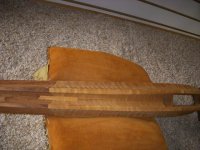New to the site, so first , Hello for Griz. I have this beautiful piece of timber that I am setting my .340 Weatherby into. As you can see, it is a piece that I do not want to mess up. So, what product would I want to use for a little color before the final finish? Would tong oil do the color job? Thnaks and I look forward to the replys. Griz
You are using an out of date browser. It may not display this or other websites correctly.
You should upgrade or use an alternative browser.
You should upgrade or use an alternative browser.
Stock Finishes
- Thread starter dagrizman
- Start date
To a certain degree, Tung Oil will darken and change the color. Just not sure if it would meet you expections. This is one beautiful piece of wood and am hard pressed as to how I would handle this one. It's not too exacting but might I suggest you get some wood samples and try different stains. Then continue with the Tung Oil and you should be able to make a better determination after two coats. I think I would go with a light redish tint. Continue to take your time let the piece talk to you as you progress. Good luck and please keep us updated !! ... 
Be Safe !!!
Be Safe !!!
That's a beautiful piece of wood. Well worth taking lots of time to finish 'right'.
Here's a couple of sites you can look at that have information of finishing a stock:
http://hunting.about.com/od/guns/a/aastockrefinish.htm
http://www.ssaa.org.au/stories/hints...finishing.html
I'd also do an on line search for articles on finishing gun stocks. There's quite a bit of information if you want to take the time to look through it.
I've used MinWax products for a couple different stocks that I've refinished. I used their stain to get a color I liked and followed that up with their Antique Oil Finish as a top coat (actually used numerous coats to get the low luster that I wanted. An alternative would be one of their poly finishes is you prefer a harder finish with more of a high gloss.
Good luck on the project and please post pictures of the final results.
Here's a couple of sites you can look at that have information of finishing a stock:
http://hunting.about.com/od/guns/a/aastockrefinish.htm
http://www.ssaa.org.au/stories/hints...finishing.html
I'd also do an on line search for articles on finishing gun stocks. There's quite a bit of information if you want to take the time to look through it.
I've used MinWax products for a couple different stocks that I've refinished. I used their stain to get a color I liked and followed that up with their Antique Oil Finish as a top coat (actually used numerous coats to get the low luster that I wanted. An alternative would be one of their poly finishes is you prefer a harder finish with more of a high gloss.
Good luck on the project and please post pictures of the final results.
When looking for stock finishes, go to the experts. Brownells sells a variety of finishes for stocks. Permalyn or Pro-Oil are my favorites, but TruOil or LinSpeed work very well. You can also buy books on stock finishing.
BTW, that is a beautiful piece of wood! In order to get the best results, you will need to remove about 1/8" of wood from all over the exterior of that stock. Read up on stockmaking to get the best results, or get some advice from a stockmaker in your area.
BTW, that is a beautiful piece of wood! In order to get the best results, you will need to remove about 1/8" of wood from all over the exterior of that stock. Read up on stockmaking to get the best results, or get some advice from a stockmaker in your area.
Welcome to the forum, Griz. Nice looking piece of wood. Over the last fifty years I have refinished the grips or stock on every pistol, rifle, and shotgun I have owned. Must be a phobia with me. My choice of wood finish is simply Casey's TruOil. It serves as its own filler and I use no artificial coloring under it. I sand the wood with progressively finer grades of sandpaper down to 600 grit, wipe stock with tack rag to remove debris/dust, WASH HANDS/FINGERS WELL (like a surgeon before surgery), dry them carefully and apply light coat of TruOil with my finger tips, let dry (usually overnight), sand lightly with 600 grit paper, and repeat up to a dozen or more times. The finish dries to a glossy lustre. If you want an egg-shell semi-gloss, rub lightly with Brownells XXX rubbing compound. If you get it too dull, rub lightly with Brownells XXXXX rubbing compound to restore gloss. If you rub thru the last finish coat, apply a new coat of TruOil and repeat with less rubbing of Brownells compound/s. I have used this approach on high grade custom built Claro walnut and French walnut rifle stocks. Have also used it on stocks for Browning Citori O/U shotguns in Field grade, Grade III, and Grade VI. Good luck with your stock.
ps: TruOil will darken the wood only VERY slightly and add a rich appearance IMO.
ps: TruOil will darken the wood only VERY slightly and add a rich appearance IMO.
Last edited:
impalacustom
New member
I wouldn't stain it or oil it, if that was mine I would use automotive clear coat on it and bring out the beauty in that maple.
On a side note, who made that stock?
On a side note, who made that stock?
As all have said, nice piece of wood. I built a flintlock years ago and I bought a stock blank much like yours. Maple will of itself darken over time with most finishes applied. The wood just darkens with time. I used Pure Tung oil on my maple stock. Not a tung oil finish, but 100% tung oil which you can get from The Real Milk Paint Co. ( www.realmilkpaint.com ) Maple is hard so it will not take too long to get a great finish. Most of the time pure tung if applied thinly will dry overnight, unlike linseed that drys in days or weeks.
You can always hasten the darkening of maple by mixing just a few drops of an oil based stain into the tung oil.
The other finish I have used on stocks is a product by Fuller-O'Brien called Fuller Plast. I have heard, but no proof, that was what Roy Weatherby originally used on his gunstocks. It can be sprayed on (easiest) or applied with a wide SOFT artist brush. It dries quickly and you can put the left over material in your freezer and it will stay fine for many days.
I have used "Tru Oil", "Linspeed" and most all of the products out there. I still like Tung Oil the best for a soft elegant shine.
Finally, the finishes sold by Brownells are great too.
Best of luck with the project, take your time and you will have a one of a kind gunstock.
You can always hasten the darkening of maple by mixing just a few drops of an oil based stain into the tung oil.
The other finish I have used on stocks is a product by Fuller-O'Brien called Fuller Plast. I have heard, but no proof, that was what Roy Weatherby originally used on his gunstocks. It can be sprayed on (easiest) or applied with a wide SOFT artist brush. It dries quickly and you can put the left over material in your freezer and it will stay fine for many days.
I have used "Tru Oil", "Linspeed" and most all of the products out there. I still like Tung Oil the best for a soft elegant shine.
Finally, the finishes sold by Brownells are great too.
Best of luck with the project, take your time and you will have a one of a kind gunstock.
I would say you have choices depending on how glossy you want it.
I've had good luck with old factory stocks and Birchwood Casey's TruOil. However...I am the happiest with a stock I did with Pilkington's. It's an oil type finish that really makes the grain glow. It is available with and without stain already in it. You can choose from several colors/shades and it's all in one bottle. I think I went with a classic red/brown with a sorta fancy walnut stock. It takes some time but is actually pretty easy. You can make it matte or more glossy. The instructions included are good and you end up with really nicely sealed pores. The stuff works like filler as you go. I got mine from Brownells, but its available through Midway, as well.
I've seen some nice stocks with Linspeed, but it can be very glossy and I didn't think it was as easy or deep looking at the Pilkington's. It was also a little fussier about setting up over time. I'm already planning on redoing a polyurethaned Beretta shotgun stock with it.
I've had good luck with old factory stocks and Birchwood Casey's TruOil. However...I am the happiest with a stock I did with Pilkington's. It's an oil type finish that really makes the grain glow. It is available with and without stain already in it. You can choose from several colors/shades and it's all in one bottle. I think I went with a classic red/brown with a sorta fancy walnut stock. It takes some time but is actually pretty easy. You can make it matte or more glossy. The instructions included are good and you end up with really nicely sealed pores. The stuff works like filler as you go. I got mine from Brownells, but its available through Midway, as well.
I've seen some nice stocks with Linspeed, but it can be very glossy and I didn't think it was as easy or deep looking at the Pilkington's. It was also a little fussier about setting up over time. I'm already planning on redoing a polyurethaned Beretta shotgun stock with it.
Thanks to all of you that took your time to reply to this post. All of the info is great. NOW, can any of you post a picture of what your finishes looked like after the process. I am getting excited now on getting started. I am taking the barreled action to a smith this weekend to have bedded and fitted to this wood. I will post more as the project gets futher along. Again, Thank you for all if the advice and I look forward to seeing your grreat finishes, Griz P.S. I will get the name and address of the guys who I bought this wood from. My stock was done in about 1970 from a gunstock maker for his own personal use but never did finish it. The Co. is in Kansas and I will post the info for all to see as soon as I get it from home. Thanks again, Griz
Griz,
I'll add my welcome to the forum.
I strongly recommend you follow a version of Pahoo's advice by trying different finishes in small patches in the barrel channel of your stock, where they won't be seen when the gun is assembled. Your piece of wood looks beautiful, but it won't absorb or be wetted by any two finishes in exactly the same way as any other piece of wood.
A cabinet maker taught me to apply Danish Oil and similar wiping varnish finishes using 320, 400, and 600 grit wet/dry automotive sandpaper in three successive coats, used in that order. Otherwise, follow the can instructions for keeping it wet and when to wipe off, etcetera. This produces a finish that resembles a tung oil finish, but is much quicker to apply.
I highly recommend to you and anyone else interested in the topic that you buy (and read) a copy of Understanding Wood Finishes (subtitle: How to Select and Apply the Right Finish) by Bob Flexner, Fox Chapel, pub., 2005. ISBN 978-0-7621-0680-6. This is a big format paperback that goes through each type of finish and its pluses and minuses. It explains varnishes, shellacs, oils, stains, dyes, waxes and other finishes in great detail with extremely well reproduced photos taken in the right lighting to show what is being discussed.
The book has lots of tips and Myth/Fact sidebars. Some of it quite surprising. I did not know that no matter how many layers of linseed oil you put on wood it would be quickly penetrated on contact with moisture and smudged (light blotch). Tung oil, on the other hand, has good water resistance but takes about a dozen coats to develop a satin finish, with several days drying between each coat. So it take a month or more to apply properly, and then some drying and hardening time beyond that before you use it. I didn't know that most wipe-on finishes with the term "tung oil" in their name have no tung oil in them at all. They are varnishes and not oils, anyway. They just produce a finish that resembles a properly applied 12 layer tung oil finish.
The book is easy reading with illustrated discussion and tips for application methods. It goes well outside gun stock finishing, since it's not aimed at us in particular, but having some background in what things finishes will and won't do will quickly narrow your choices.
I'll add my welcome to the forum.
I strongly recommend you follow a version of Pahoo's advice by trying different finishes in small patches in the barrel channel of your stock, where they won't be seen when the gun is assembled. Your piece of wood looks beautiful, but it won't absorb or be wetted by any two finishes in exactly the same way as any other piece of wood.
A cabinet maker taught me to apply Danish Oil and similar wiping varnish finishes using 320, 400, and 600 grit wet/dry automotive sandpaper in three successive coats, used in that order. Otherwise, follow the can instructions for keeping it wet and when to wipe off, etcetera. This produces a finish that resembles a tung oil finish, but is much quicker to apply.
I highly recommend to you and anyone else interested in the topic that you buy (and read) a copy of Understanding Wood Finishes (subtitle: How to Select and Apply the Right Finish) by Bob Flexner, Fox Chapel, pub., 2005. ISBN 978-0-7621-0680-6. This is a big format paperback that goes through each type of finish and its pluses and minuses. It explains varnishes, shellacs, oils, stains, dyes, waxes and other finishes in great detail with extremely well reproduced photos taken in the right lighting to show what is being discussed.
The book has lots of tips and Myth/Fact sidebars. Some of it quite surprising. I did not know that no matter how many layers of linseed oil you put on wood it would be quickly penetrated on contact with moisture and smudged (light blotch). Tung oil, on the other hand, has good water resistance but takes about a dozen coats to develop a satin finish, with several days drying between each coat. So it take a month or more to apply properly, and then some drying and hardening time beyond that before you use it. I didn't know that most wipe-on finishes with the term "tung oil" in their name have no tung oil in them at all. They are varnishes and not oils, anyway. They just produce a finish that resembles a properly applied 12 layer tung oil finish.
The book is easy reading with illustrated discussion and tips for application methods. It goes well outside gun stock finishing, since it's not aimed at us in particular, but having some background in what things finishes will and won't do will quickly narrow your choices.
Last edited:
For those who asked who built my stock in this post, You can find there GREAT works on Gun Trader.com under rifle parts, stocks. There ID is countrygirl1993. Look for the post with a # at the end, ie. such & such stock 103. They are located in Sedgwick Ks. I can not say enough good about them & there service. The prices are also great. Check them out and tell them Griz sent you to them. Enjoy your search, Griz
Inspector3711
New member
Another vote for oil since the wood is figured so nicely... I did this one in Tru oil awhile back... It was originally stained dark and varnished in the early 1970's. Eventually I will strip it again and see if I can lighten it up some more. It's probably half as dark as it was when I got it. The process took a couple of weeks.

Here's a pic of my latest project.. 1986 Yugo SKS.. I brushed a coat of glossy poly on and let it dry for 24 hours. Next I sprayed four coats of matte poly on for a nice low gloss finish.


Here's a pic of my latest project.. 1986 Yugo SKS.. I brushed a coat of glossy poly on and let it dry for 24 hours. Next I sprayed four coats of matte poly on for a nice low gloss finish.

fisherman66
New member
Potassium permangenate will darken it golden yellow to brown. Ferrous sulfate will darken the waves. Do a little googling on maple and PP and FS.



